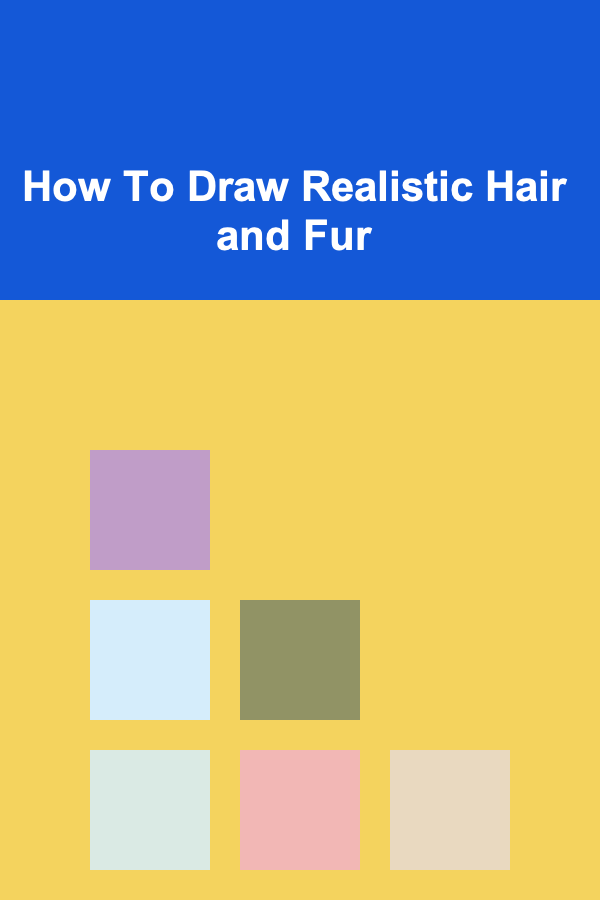
How To Draw Realistic Hair and Fur
ebook include PDF & Audio bundle (Micro Guide)
$12.99$8.99
Limited Time Offer! Order within the next:

Drawing realistic hair and fur is a skill that requires patience, practice, and an understanding of the natural textures and flow found in both hair and fur. Whether you're drawing a human portrait, an animal, or even a fantasy character, the techniques for creating realistic hair and fur are essential for bringing your artwork to life. This article will guide you through the key concepts and steps needed to master the art of drawing hair and fur realistically.
Understanding Hair and Fur Structure
Before you start drawing, it's important to understand the structure of hair and fur. Both hair and fur grow from follicles located in the skin and are composed of keratin, a tough protein. While hair tends to be longer, straighter, and often smoother in texture, fur is typically shorter, denser, and more layered, with various types of undercoats and guard hairs.
Hair
Human hair is composed of three main layers:
- Cuticle -- The outermost layer made up of overlapping scales.
- Cortex -- The middle layer that contains pigment (color) and gives hair its strength and elasticity.
- Medulla -- The innermost core, present only in some types of hair, providing additional strength.
Hair can have various textures, including straight, wavy, and curly. It also can reflect light, giving it a shiny appearance or matte finish, depending on the natural oils present.
Fur
Fur, on the other hand, is typically found in mammals and is made up of two main types of hair:
- Guard Hairs -- These are the longer, coarser hairs that form the outer layer of fur. They protect the softer undercoat beneath.
- Undercoat -- Shorter and denser hairs that provide insulation.
Fur is generally softer than hair and often has a different shine or matte finish. It may also be arranged in tufts or clumps, especially in animals with thick coats, such as wolves or cats.
Key Tools for Drawing Realistic Hair and Fur
To achieve realistic results, it's important to use the right tools for the job. Whether you're working traditionally with pencils or digitally with a tablet, the following tools are essential:
Traditional Drawing Tools
- Graphite Pencils -- For fine lines and detailed shading, use a range of graphite pencils. Softer pencils like 6B or 8B work well for darker areas, while harder pencils (such as 2H or HB) are useful for lighter details.
- Colored Pencils -- If you're working with color, high-quality colored pencils will allow you to layer different shades to create depth and texture.
- Blending Stumps or Tortillons -- These are essential for blending the hair or fur strokes to achieve smooth transitions and natural-looking texture.
- Eraser -- A precision eraser (such as a kneaded eraser) is key for lifting out highlights or correcting small mistakes, especially in fine details.
Digital Drawing Tools
- Tablet and Stylus -- A good quality tablet and stylus allow for precise control and a variety of brush settings.
- Brushes -- Digital brushes that mimic the effect of traditional pencils or natural media (like fur or hair brushes) can be incredibly helpful for creating realistic textures.
- Layering and Opacity -- Digital art allows you to work in layers, which is useful for building up depth in your hair and fur details gradually.
Step-by-Step Guide to Drawing Realistic Hair
Creating realistic hair requires a structured approach. By focusing on the direction of the hair, the way light interacts with it, and how to build up layers, you can achieve a lifelike result.
1. Start with a Basic Outline
Begin by sketching the basic outline of the head or body and determining where the hair will fall. Whether it's flowing down or styled in a specific way, map out the general shape and direction of the hair. Keep the strokes light, as you'll be refining the details later.
- Use simple guidelines to mark where the hairline begins, how the hair should fall, and where it might curve or twist.
- Think about how the hair moves naturally---avoid making the hair appear too stiff or forced. The hair should flow naturally with the shape of the head and shoulders.
2. Define the Direction of the Hair
Hair follows a specific direction as it grows from the scalp. You need to understand the natural flow of the hair and how to represent that in your drawing.
- Straight Hair -- Straight hair grows in uniform, smooth lines. The individual strands may seem parallel, but subtle variations in direction will give the hair texture.
- Curly or Wavy Hair -- Curly or wavy hair has more texture and volume, with each strand curving and twisting. You can use S-shaped or spiral strokes to represent these curls.
- Layers -- Realistic hair often has layers, which create volume and movement. Be sure to indicate different lengths and how they layer on top of each other.
3. Add Texture and Volume
Now that you've outlined the direction, you can begin adding volume and texture. Hair is rarely flat against the scalp, and it typically has movement due to wind, gravity, or styling.
- Shading -- Use light and shadow to create depth. Lightly shade areas where the hair falls, and leave the areas that catch light brighter. Hair typically has highlights that shine, so ensure that you leave lighter strokes for these reflective spots.
- Strokes and Layers -- For more realism, create layers of hair by drawing several strokes in different directions. Each layer should overlap the others to simulate the natural thickness of hair.
4. Refine the Details
Once you've built up the basic texture and volume, focus on refining the details. Pay close attention to where the light and shadows are hitting the hair. Use an eraser to lift out highlights, particularly on areas where light would hit the hair most, such as the top or the outer strands.
- Soft Lines for Curves -- If you're working with curly or wavy hair, use softer lines to reflect the smoothness of the curls.
- Fine Strands -- For straight hair, individual strands may be more visible. Draw these with light strokes, ensuring they don't dominate the whole drawing but add a sense of detail.
5. Final Adjustments
Make the final adjustments to your drawing by refining the light, shadow, and texture. This includes darkening areas that are in shadow, brightening highlights, and smoothing out the transitions between light and dark areas.
Step-by-Step Guide to Drawing Realistic Fur
Drawing fur shares many similarities with hair but requires additional focus on texture and layering. The denser nature of fur means that you have to be mindful of how the individual hairs group together and how to simulate the softness and variation found in real fur.
1. Outline the Fur's Shape and Flow
Start by sketching the basic outline of the animal or object you're drawing. This includes marking the general direction of the fur's flow. Fur is generally denser around certain areas like the neck, chest, and belly, while it may be more sparse around the face or tail.
- Create gentle curves in the fur lines to reflect natural flow. Fur doesn't fall in straight lines; instead, it follows the contours of the body and limbs.
2. Build Up Fur Layers
Begin by creating short, soft strokes to simulate the individual fur strands. Focus on how the fur naturally groups together, keeping the following tips in mind:
- Guard Hairs -- These longer hairs form the outer layer of the fur and give it texture. Use slightly longer strokes for these guard hairs, particularly around the edges of the animal's body.
- Undercoat -- The undercoat is denser and softer, so you should use shorter strokes in these areas. The undercoat often blends with the guard hairs, creating a smooth transition.
3. Add Texture and Shading
Shading is crucial in creating realistic fur. Fur, like hair, has highlights and shadows that define its texture.
- Directional Shading -- Fur tends to reflect light based on its angle. For example, fur on the back of an animal may catch more light than fur on the underside. Use a gentle gradient to suggest the lightness and softness of fur.
- Layering Strokes -- Fur layers can overlap, creating shadows between them. Layer your strokes by starting with softer fur textures and adding detail gradually.
4. Define the Fur's Characteristics
Different animals have different types of fur. For example, a wolf's fur is thicker and coarser, while a cat's fur is smoother and more flexible. Adjust your strokes and shading accordingly.
- Animal-Specific Features -- Study the animal you're drawing closely. Notice the specific texture of their fur, and replicate it with varying lengths, thicknesses, and stroke directions.
5. Final Touches
As with hair, the final touches will make the difference between a good and a great fur drawing. Use a combination of erasing for highlights and adding dark strokes for deep shadows to emphasize the three-dimensionality of the fur.
- Highlights and Reflections -- Use an eraser to gently lift out small areas where light reflects off the fur. These highlights are often seen along the edges of the fur or the tips of the guard hairs.
Conclusion
Drawing realistic hair and fur requires understanding their structure, texture, and behavior under different lighting conditions. Whether you're working with hair on a human character or fur on an animal, the key to realism lies in the details: the direction of the hair, the way light interacts with the texture, and the layering of strokes to create depth.
By practicing these techniques and experimenting with different approaches, you can refine your skills and learn to create stunning, lifelike hair and fur in your artwork. It takes time, but with patience and dedication, you'll master the ability to draw hair and fur that adds depth and realism to any piece.
Other Products

How to Add a Stylish Touch to Your Home Renovation on a Budget
Read MoreHow to Develop a Customer Feedback Management Checklist for Tracking Key Metrics
Read More
How to Prepare Quick & Healthy Stir-Fries
Read More
How to Protect Your Home's Wi-Fi Network from Hackers
Read More
How to Start Your Own Side Hustle in the Beauty Industry as a Stylist's Partner
Read More